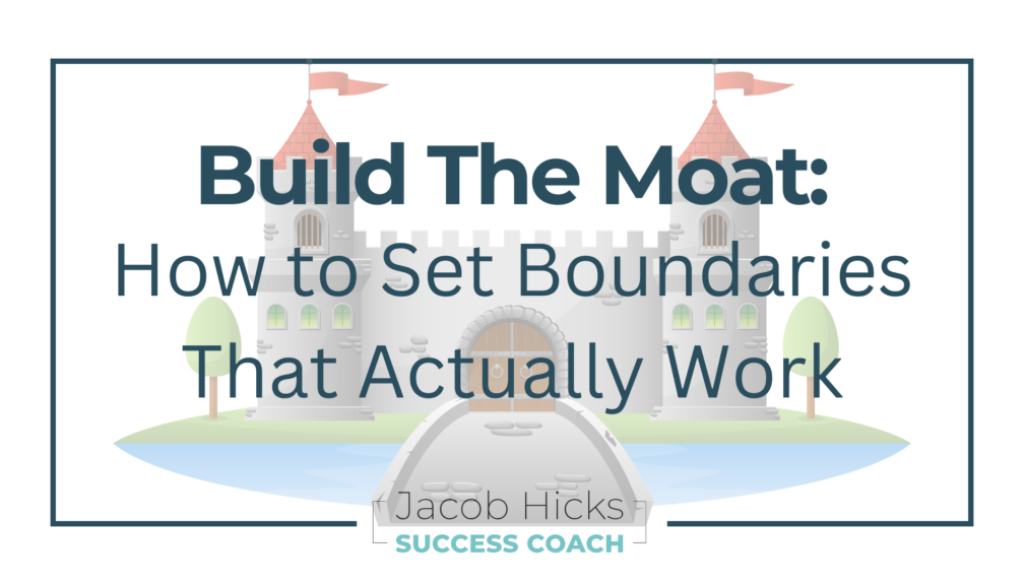Building The Moat
Building the Moat: How to Set Boundaries That Actually Work
Boundaries aren’t barriers—they’re bridges to better balance. Yet, for so many of us, setting and maintaining them feels like an uphill battle. I learned this firsthand during my early days in outside sales, where long hours and unpredictable schedules made it easy to let work consume my life. But as I discovered, boundaries aren’t just about saying “no”—they’re about making space for what truly matters.
The Night That Changed Everything
One evening, I sat alone in an open house I had scheduled on a weeknight—an unusual experiment to see if I could attract more serious buyers. The house had a split-level layout, meaning I walked in to be greeted by two sets of stairs. I made my way to the living room, settling onto the least comfortable couch I had ever encountered—a beige monstrosity with zero nap potential. The air was thick with the overpowering scent of a lemon plug-in, and I sat there, twiddling my thumbs, waiting.
And waiting.
And waiting.
Not a single person showed up.
At the end of the night, I went home feeling exhausted, defeated, and, worst of all, buried in work that didn’t need to be done immediately. I finally wrapped up around 10 p.m., realizing that nothing I did after hours that night was urgent. I had let work seep into every corner of my life. Enough was enough—I needed to build a moat.
The Strategy: Building the Moat
I call my approach to boundaries Building the Moat because that’s exactly what it is: creating a protective space around what truly matters. If you’re tired of feeling like work, responsibilities, or even other people’s expectations are running your life, it’s time to put some intentional structure in place.
Step 1: Define Your Priorities
Before you can set boundaries, you need to know what you’re protecting. What matters most to you? Is it making it home for dinner with your family? Is it carving out time to work on your side business? Is it prioritizing your mental and physical health? Whatever it is, define it clearly. If you don’t set your priorities, someone else will set them for you.
Step 2: Communicate Clearly and Kindly
A boundary that isn’t communicated is just a wish. Let people know what your limits are—whether it’s telling your boss that you won’t check emails after 6 p.m. or explaining to friends that you won’t be available for last-minute plans every weekend. The key is to be firm but kind. Use I statements like, “I need to prioritize my family time in the evenings, so I won’t be available after work hours.” This makes it about your needs, not their behavior.
Step 3: Stay Consistent
Setting a boundary once isn’t enough—you have to enforce it. If you tell people you’re unavailable after a certain time, but then you still respond to every text, call, or email, you’re sending mixed messages. Boundaries only work when they’re maintained.
Step 4: Expect (and Overcome) Pushback
When you set boundaries, people may push back—not necessarily because they’re trying to be difficult, but because they’re used to you operating a certain way. If you’ve always been the person who says yes to everything, your new approach might surprise them. Stay firm and remind yourself why these boundaries matter to you.
Step 5: Work Hard, Rest Hard
There are seasons for hustle, and there are seasons for rest. If you’re in a period of intense work, make sure you’re also scheduling time to recharge. Set intentional rest periods—not just aimless scrolling on your phone, but real, fulfilling rest like spending time with loved ones, pursuing hobbies, or simply doing nothing. If you can’t take an entire day off, start with a few hours and build from there.
Lessons from My Father
My dad was larger than life. He showed up for every school event, every tennis match (even though my tennis career was… let’s just say, brief), and every important moment. I don’t know if he ever sat down with a boss or my mom to formally discuss boundaries, but he knew what kind of father he wanted to be. He made sure that work was never the most important thing in his life.
Of course, he wasn’t perfect. There were times he got caught up at work and ran late picking me up from school. But I don’t remember the late pickups as much as I remember that he was always there when it really counted.
That’s the point.
Boundaries aren’t about perfection. They’re about intention.
Your Turn: Build Your Moat
If you’re feeling stretched too thin, overwhelmed, or like your time is no longer your own, take this as your sign to start building your moat.
- What are the most important things in your life?
- What boundaries do you need to set to protect them?
- How will you communicate and enforce them?
Start small. Test things out. And remember—boundaries aren’t selfish. They allow you to show up better in every area of your life.
Thanks for reading! If this resonated with you, share it with someone who might need a gentle reminder that boundaries aren’t barriers—they’re the key to balance.
